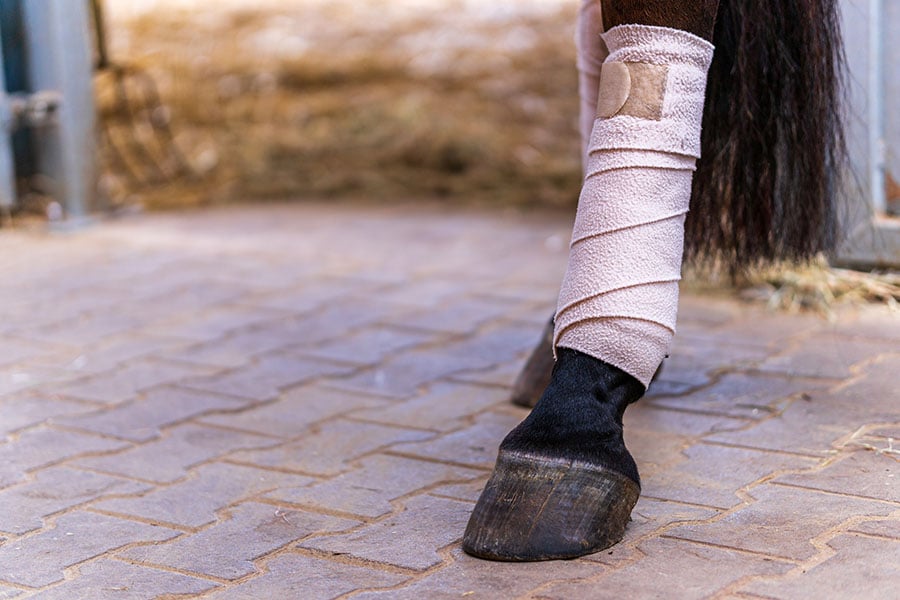You may have heard stories of equestrians whose horses sustained critical tendon injuries and could not continue training. Riders had to allow their horses several months of rest before getting back to their daily arena sessions. Not only does this take time away from competitions you could pursue, but if you have equestrian clients, you will lose their business when their horse cannot use your facility.
It is necessary to understand how to prevent tendon and ligament injuries in horses for the good of you and your clients’ performance horses. Before you spend wasted time and money on recovery in the future, here are some tips for how to care for your horse now. They will keep your horse’s tendon injuries to a minimum and decrease the likelihood of other injuries too.
Buy Conformation Horses
While there is no such thing as a perfectly conformed horse, choosing to buy your horse with conformation in mind helps prevent tendon injuries. This is because some horse conformations are more prone to certain injuries than others. For example, horses with a straight spine down to their hind end commonly develop hock and high-suspensory problems.
You may have to compromise conformation in some cases where the specific breed or intelligence is more important. However, it is best to find the best of both worlds by purchasing a competition horse that values conformation and performance.
Invest in Reliable Footing
Another valuable tip for preventing you and your clients’ horse tendon injuries is to supply your arena with stable footing. Riding over uneven footing or areas with deep footing stresses your horse’s tendons and can lead to soft-tissue injuries. Horse arena footing has a tremendous affect on your horse’s overall performance.
Most equestrians do not consider their horse footing when protecting their horse’s tendons for future competitions. However, this common mistake can lead to your horse being out of commission for several months. It is not worth wasting time and energy on damaged tendon recovery, in our opinion, when you could have instead invested in reliable horse footing.
Ensure Good Shoeing
Good shoeing, just like with humans, is a great way to protect their hooves and stop tendon injuries before they begin. During competition training sessions, proper horseshoes will promote anti-inflammatory activity and reduce stress on their hooves. They can also keep other soft-tissue structures safe and prevent further physical injuries.
Maintain Proper Conditioning
To keep your horse far away from tendon injury potential, correct conditioning is a necessity. You should mix your hard competition training with less strenuous activities, such as slow, long-distance walks. This will help protect specific tendons and ligaments and strengthen all parts from heat and swelling.
It is also important to give your horse breaks during arena training and not work them too hard to the point of exhaustion. Poor conditioning, even with small errors, can lead to poor muscle response, and tendon stabilization. In instances where your horse’s training involves heavy jumping, their superficial digital flexor tendon and deep digital flexor tendons can suffer.
They will be incapable of performing at their best, overall, and can suffer from serious injuries if you are not careful.
Cross Train Your Horse
Variety in your horse’s riding terrains, while occasionally traveling uneven ground, will keep tendon injuries to a minimum. You can ride your horse in your training arena, on a trail ride, through your field, etc to get them familiar with different riding environments. Cross-training, in addition to trot sets, will strengthen your horse’s core and hind end and prevent future tendon injuries.
Treating Tendon Injuries in Horses
If you do not apply these strategies to your regular training strategy, your horse can get a tendon injury, which takes around 12 months to heal. Recovery is always a drawn-out process that does not consider your upcoming competitions or arena facility income.
There are two primary ways your horse’s tendons heal and you can help treat it for the long haul. Stem cell therapy, where a veterinarian injects a horse’s fatty tissue or bone marrow cells into their tendon, is one treatment option you can take. This option can take care of specialized areas, such as flexor tendons and tendon sheaths, that require specific care.
Finally, you can improve blood flow and blood supply with extracorporeal shock-wave therapy, starting the healing process.
Equestrians with a Tendon Injury Solution
You can prevent your and your clients’ horse tendon injuries by following these practical tips during general care and training. We do not recommend waiting until your competitor gets a tendon injury before you do something about it. If you choose to ignore shoeing, conditioning, and other practices, you will waste time and money you wish you had not.
We are horse riders just like you that are knowledgeable about protecting our star horses from physical damage that stops performance. If you have questions about any of our suggestions or other ways you can prevent tendon injuries, feel free to reach out.
You can call our team at (877).835.0878 or send us a note online through our virtual contact form.
